ABSTRACT
This paper describes a survey of technologies and to what extent they support virtual project based learning. The paper argues that a survey of learning technologies should be related to concrete learning tasks and processes. Problem oriented project pedagogy (POPP) is discussed, and a framework for evaluation is proposed where negotiation of meaning, coordination and resource management are identified as the key concepts in virtual project based learning. Three e-learning systems are selected for the survey, Virtual-U, Lotus Learningspace and Lotus Quickplace, as each system offers different strategies for e-learning. The paper concludes that virtual project based learning may benefit from facilities of all these systems.
Keywords
Project based learning, learning environment, POPP, PBL
INTRODUCTION
Technologies designed with the purpose of supporting virtual learning environments are not neutral. They reflect a certain understanding of communication and a certain understanding of learning, which is represented and incorporated in the functionality of the system, in the system architecture and in the interface design. But system developers rarely provide an explicit definition of the underlying pedagogy of their system and therefore it is difficult to choose an appropriate technology when designing and organizing learning environments. The purpose of this paper is to define a methodological basis for evaluation of technological solutions, which aim to support problem oriented project based learning (POPP) (Illeris, 1981; Dirckinck-Holmfeld, 1990). However, a survey of learning technologies implies different approaches and different aims.
One approach is functionally motivated and consists of technical specifications of functions that must be included in a proper design. While evaluating technologies that support communities of practice, Etienne Wenger (2001) presents a set of technical functions used as a basis when evaluating different computer systems. This kind of survey is only provides a technical understanding of a virtual community of practice (Wenger, 1998). It is a survey based on expectations of the technology instead of actual pedagogical experiences.
Another approach is a survey based on a pedagogical or learning theoretical mapping. Dr Tom Reeves (1997) has described fourteen pedagogical dimensions of computer-based education (CBE). The universal dimensions are used for evaluation of CBE and for comparative evaluations. The question is whether or not universal dimensions correspond with the specific aspects of different educational systems and different pedagogies. This paper argues that they are too general and have limited value when evaluating technological solutions for project based learning.
The survey in this paper is therefore based on a third approach where the focus is on a concrete learning strategy used in practice, the project method, and where the survey is based on the different processes and activities involved in project based learning. The argument is that a survey of learning technologies must focus on how learning activities evolve through the technology. The central aspect is the learning activities, and learning activities should be in focus when designing and analysing learning technologies. Problem oriented project based learning is characterized as a learning process powered by the students The problem is defined and formulated by the students in collaboration, and they are in control of the process of negotiating and defining what to be learned from the study of the problem. The challenge is to design environments and choose between technologies where these processes are supported..
Problem oriented Project Pedagogy - popp
Problem Oriented Project Pedagogy (POPP) was the pedagogical foundation for establishing Aalborg University (1974) and Roskilde University (1972) in Denmark. It represented a radical change compared to teaching and study methods applied at that time. The emphasis shifted from a traditional model based on lectures and delivery of knowledge towards a critically and experientially based pedagogy favouring learning as knowledge construction through genuine collaboration (Dirckinck-Holmfeld, 2002). In POPP, the students themselves define in collaboration the problems and learning goals. This is where POPP differs from traditional PBL (problem based learning) and CBL (case based learning), which are both based on predefined tasks or problems decided by the teacher or the textbook. In POPP, the entire educational process is based on the students' focus on a scientific and social problem (inquiry), which they want to investigate. When students themselves define and formulate the enquiry, they experience conscious feeling of ownership, and they regard it as a problem (anomaly), which implicitly encourages involvement and motivation. Participant control and the ownership of the problem setting are therefore seen as fundamental for the students' engagement in the learning process. Participant control implies that the institution or the teacher is unable to steer the process, they can only guide the learning process, and the teachers are not supposed to project ideas on the students despite of well-intentioned purposes.
A conceptual framework for evaluation
In order to evaluate different technologies and the way in which they support project based learning, the different processes and activities involved in the project method must be identified. We have determined three central concepts: negotiation of meaning, coordination and resource management. The identification of these three concepts is partly based on a theoretical understanding of how people collaborate and learn in social contexts (Wenger, 1998; Schmidt 1994; Strauss 1985,1988; Fjuk and Dirckinck-Holmfeld, 1999) and partly based on experiences from designing and investigating learning environments (Tolsby, 2002a).
Negotiation of meaning. According to Wenger (1998), social learning can be described as continuous negotiation of meaning between participants in a certain practice. Wenger defines negotiation of meaning as two constituent processes: participation and reification. These two processes exist in duality, affecting each other as a source for developing each other.
Participation is an active process, which Wenger reserves for actors who are members of social communities. "Participation in this sense is both personal and social. It is a complex process that combines doing, talking, thinking, feeling, and belonging. It involves our whole person including our bodies, minds, emotions, and social relations." (Wenger, 1998, p. 56).
Reification describes our engagement with the world as production of meaning. "Reification … refers to the process of giving form to our experience by producing objects that congeal this experience into "thingness" …Reification can refer both to a process and its product." (Wenger, 1998, p. 58-60).
But since production of meaning is extended across reification and participation, a dynamic relationship between the two must be established. If this is not the case, if either of the processes are being dominated or oppressed, the negotiation and construction of meaning may be problematic.
Coordination plays a central role in accomplishing mutually dependent learning processes (Fjuk og Dirckinck-Holmfeld, 1999) and in shared activities (Schmidt, 1994; Strauss, 1985; Strauss, 1988). It is a matter of different phenomena demanding coordination. Pooled interdependence; meaning a shared understanding where the individual contributions are crucial, and where the whole has influence on the individual. Sequential interdependence; where single contributions are needed for progression in the project, and finally reciprocal interdependence; referring to the situation where result of the individual is input for the others and vice versa. (Thompson 1967, p. 54-55, in Schmidt 1994, p. 13)
In the project method all these needs of coordination will be present, and they must be supported and made visible for the participants to prevent the process from stagnating and dissolving.
Resource management denotes the task of organizing and sharing materials and tools, which are available for the project. It includes resources found or produced by students themselves or in collaboration, and it includes recourses made available for them by e.g. the teacher. Because project based learning is an open learning situation, the resources frame the problem domain making resource management a central task.
Categories of E-learning systems
There are numerable e-learning systems on the market and it is rather confusing and difficult to understand the potential of the different systems while they are based on different technologies and support different learning strategies. No system is pedagogically neutral, and the choice of system sets the frames for what is possible to achieve. Depending on the functionality provided by the e-learning system, it is possible to arrange the systems according to distinct categories.
Content delivery systems are systems where the main function is organization and publication of teaching material. Such systems have dominated the market with the consequence that most e-learning is organized as traditional classroom instruction. Examples of systems in this category are Lotus Learningspace, WebCT and Blackboard.
In conference systems, the main function is dialogues in asynchronous (text) media. These systems have roots in the bulletin board systems (BBS), which existed before the WWW. Examples of systems in this category are Virtual-U and FirstClass.
In groupware systems the aim is coordination of group activities. The purpose of the activities can either be production oriented or just socially motivated. There are several Internet Service providers (ISP) providing free access to functional groupware systems e.g. Yahoo-Groups, Groupcare and iGroups. Examples of commercial groupware systems are Lotus QuickPlace and Communispace.
These categories are not absolute descriptions, and many systems have functions crossing the categories. Nevertheless, most systems have a dominating functionality that justifies its placement in a category. In order to discuss the potential of the different categories, we have chosen to evaluate one system from each category: Learningspace (content delivery system), Virtual-U (conference systems) and QuickPlace (groupware systems).
Experiences
The evaluation of the three e-learning systems is based on experiences from using the systems in virtual projects for both on-campus educations and for distance educations at Aalborg University. The conference system Virtual-U has been used as the platform for an online master’s programme on ICT and learning. Various groupware systems (Groupcare, iGroups and QuickPlace) are used by on-campus project groups in order to structure the work and coordinate activities. Furthermore an experiment has been conducted on using Learningspace for organizing an entire semester in one of the on-campus educations.
In addition, these experiences of practice are objects of research, where the aim is a better understanding of virtual learning and an improvement of practice. The experiences referred to in this paper are based on quantitative and qualitative research methods, including observations of the activities of the students and how they organize their virtual project, discourse analyses of virtual dialogs, and semi-structured interviews with individual students and groups (Nyvang, 2002; Tolsby, 2002b).
Virtual-U (version 2.5)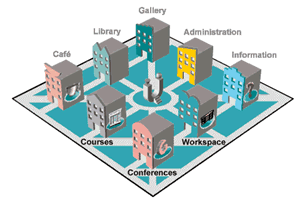
Virtual-U was originally developed at the Simon Fraser University in Canada as a part of research projects on tele-learning. In 1996, it became a commercial product by Virtual Learning Environments Inc. (VLEI), which is further developing, selling and supporting the software. According to VLEI, Virtual-U is based on the recognition that "online education is more than publishing course lecture notes on the Web". The main tool in Virtual-U is therefore asynchronous conferences, where the focus is interaction and dialogues between students and between students and teachers.
Figure 4. The interface of the Virtual-U ia based on a dominating campus metaphor.It is an open question what this metaphor adds of usability to a virtual learning environment.
Negotiation of meaning
In Virtual-U, negotiation of meaning is first of all supported by the asynchronous conferences that can be created on demand both by students and teachers. Asynchronous conferences are characterized by their ability to display participation. The number of postings, which each participant has produced, is indicated as well as the thread in which they have placed themselves in the process. Because it is visible for all, even the teacher, it creates a commitment towards participation, and a demand for explanation if one is absent or invisible in the process.
However the conferences often turn out to be long and comprehensive lists, and a student-project can easily include several hundred postings. Then it becomes a challenge to summarize, to create order and understanding and to reify the meaning created, in order to prevent the process from going in circles or dissolving, loosing the focus of the project.
One way to create a better overview and meaning of the project conferences is to use sub-conferences in order to organize the different processes in the project. Figure 2 shows the way in which a project group has organized itself in Virtual-U, deliberately using sub-conferences, and creating different rooms for negotiation. Although the names in figure 2 are in Danish, it is clear that Project Group 2 created five sub-conferences: one for literature, one for announcements, one for project guidance, one for project steering, and one for discussion of cases.

Figure 5. Utilization of sub conferences in order to structure project work.
866 postings, in total, were produced during the project period, but by organizing the project in different rooms, the process became more clear, and it became easier to reify the meaning being constructed.
Nevertheless, reification of meaning is challenging in asynchronous conferences. Even though sub-conferences may be attractive for structuring the dialogue, conferences are difficult media for navigation and overview when the amount of postings becomes large. Although the negotiation process has been reified in the conference threads, the meaning may easily disappear in the overwhelming complexity. Neither does conscientious summarizing dialogues, trying to reify the meaning in unifying documents, imply that the constructed meaning becomes an active part of the shared repertoire of knowledge of the project groups. In asynchronous conferences, summaries and other constructions of meaning will easily disappear as just another posting among hundreds of others. In addition, it is difficult to summarize a shared process in a conference, because editing each other’s postings is not allowed for in the system.
Coordination
Asynchronous conferences do not provide any structure where coordination can be reified. As discussed above, conferences are useful for visualizing participation in a negotiation process, but it is difficult to reify coordination as a shared understanding in a conference posting. Another coordination problem in conferences is dominating participants. A participant who is more familiar with expressing him/herself in writing can easily override the rest in the group, and others may choose to withdraw themselves as they experience that others are taking the control.
Virtual-U provides a template tool for structuring activities as well as a calendar, but these tools are closely connected to the course-model which is the basis for the Virtual-U design, and which is difficult to adapt to project-pedagogy. However, there are examples of project groups trying to adapt their project structure to the course model, because it provides a needed overview.
Resource management
In Virtual-U, resource management is placed in conferences, where project members can post relevant resources, documents, links, suggestions for literature and so forth. The advantage of using conferences is that a discussion can be linked directly to the resource and the participants may exchange views regarding the content of the resource, different interpretations and whether or not it is relevant for the project. The disadvantage is that it is difficult to navigate in a conference. The conference structure does not provide adequate overview and it is impossible to regroup and reorganize postings and create order in the resources.
Lotus Learningspace (version 4.0)
Learningspace is a content delivery platform. In other words, Lotus Learningspace can be seen as a way of transfering traditional classroom teaching and learning into e-learning. A teacher plans a course, builds a structure in Learningspace, adds content to the structure and makes it public. Students access the course and study the web-based content. Teachers and students may choose to combine the work with the predefined content with synchronous or asynchronous communication and thereby add a collaborative element to the learning process.
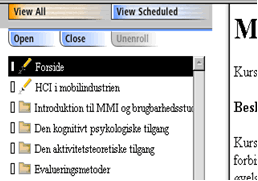 |
|
Figure 6, The structure students meet in Learningspace. A click on one of the units opens a learning resource in the right side of the browser window keeping the structure visible in the left side. |
Learningspace consists of two main modules: core and collaboration. As the name indicates, core hosts the primary functions and is used to deliver course content asynchronously to students. Content is not produced inside Learningspace but in external tools such as web editors, word processors and multimedia development environments. The only technical demand is that the content must be in a format, which can be read by a web browser. The core adds structure to the content and keeps track of the students’ work and how long they work by keeping a log of student activity. Another way of monitoring students is by setting up questionnaire-based assessments in Learningspace.
The collaboration module supports synchronous and asynchronous communication between distributed participants. The asynchronous communication is in writing and takes place in a discussion forum such as conferences or newsgroups, while the synchronous communication takes place as a text-based chat or on a shared whiteboard or as desktop videoconferencing.
Negotiation of meaning
In collaboration between students and between students and teachers, each participant has a choice between several ways of participation. Here, it is important to notice what can be described as the balance between participation by reading and participation by publishing. In problem oriented project pedagogy, both teachers and students need to read as well as to publish. If one group is not participating by publishing, genuine collaboration with or within this group is not supported by the system. In Learningspace, participation by reading is uncomplicated in both the content delivery module and in the collaborative module, whereas participation by publishing is easy in the collaborative module, but difficult in the content delivery module.
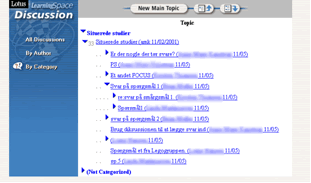 |
|
Figure 7, Asynchronous text based communication in Learningspace. |
In order to publish in the content module, users need permissions that are not intended for students. Furthermore, it is necessary to change mode by logging off from the course interface and then with teacher privileges log onto the course design module. An additional problem is that reading content is not possible in the course design mode, so in order to test your publication you have to log off and log onto the course mode again.
When discussing participation and especially participation by reading it is also relevant to look at the visibility of the participation because, to a large extent, visible participation is what ties the project group together. Participation by reading postings in a discussion is not visible to other participants unless the reader chooses to post a short awareness building note. However, when it comes to using resources in the content management module, teachers have the possibility of tracking students automatically.
From the perspective of problem oriented project pedagogy, the primary critique of Lotus Learningspace is that functionality and interface in the content management module, which is the main gate to the system, primarily invites a linear process. The teacher or instructional designer plans a course, collects or develops resources, sets up a structure in Learningspace, lets students into the course and collects answers to assignments at the end. During learning in a problem oriented context, all participants, not only teachers, have to participate and reify the participation in a way that may or may not change the course of the project. On the other hand, if viewing the content management module as a resource base and the collaborative module as the main forum for negotiation of meaning, the picture is more complete and real potential in Lotus Learningspace shows.
Coordination
When two or more people learn or work together, the calendar is one of the most basic tools for coordination. Lotus Learningspace does not offer a traditional calendar tool. Instead, dates and deadlines can be plotted into each course schedule. In the collaboration module, a similar feature allows users to announce synchronous collaborative events. This is perhaps the most important tool for coordination in Learningspace because the synchronous events obviously calls for a more precise down to last minute coordination, since all participants have to be present at the same time in a way that is unknown in asynchronous events.
Resource management
The content management module in Learningspace is one way of managing electronic resources for learning purposes. As discussed earlier, Learningspace only brings structure to content authored outside the system. This means that making smaller additions and changes may cause some inconvenience because the teacher needs to shift to another tool to do it. In the synchronous meetings, participants have better opportunities of working directly on content in e.g. the shared whiteboard. These opportunities also have to be taken into account when evaluating Lotus Learningspace.
When it comes to editing resources it is also relevant to mention that knowing when, by whom and perhaps why a resource has been revised is sometimes useful. In the production phase of a project, documents are continuously revised and handed from one participant to another and the meta information may prove to be a useful clue in understanding the status of a document. Learningspace does not support visualization of resource history, but the external tools used to author content usually do.
Lotus Quickplace (version 2.08)
Lotus Quickplace is a groupware system and as such it is not designed exclusively for learning support. As a piece of groupware, on the other hand, it is interesting to see the way in which it supports learning in group and project-based learning.
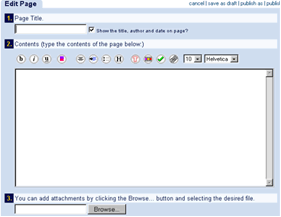 |
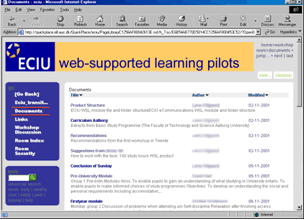 |
|
Figure 5, Window for production of content in Lotus Quickplace. |
Figure 6, Typical Lotus Quickplace interface |
Quickplace is browser based which means that you connect to the system through an ordinary web browser. The system primarily offers tools for asynchronous communication in relation to a shared project. The users (both teachers and students) have access to: discussion forums, calendar, task lists, link libraries and document libraries. Quickplace also offers a text-based chat for synchronous communication. Before moving on to further describing the different tools, it should be pointed out that Quickplace has a flexible interface. Administrators are free to choose e.g. interface layout, colours and how many tools they want to be visible. With the necessary technical insight it is also possible to program a new interface layout from scratch.
Compared to other systems, as for instance Lotus Learningspace, it is important to notice that, in Quickplace, content may be produced in either the system or by external tools. It is also possible to attach files written in e.g. a word processor to any piece of content you produce in Quickplace.
Negotiation of meaning
In Quickplace it is obvious that collaboration within a group can take several forms or at least involve a number of different activities. Participation by reading resources of various kinds is a clear example but, as in Lotus Learningspace, participation by reading is invisible in Quickplace. Participation is only visible when it is combined with production of content – postings in a discussion, documents in the library or appointments in the calendar just to mention a few examples.
There is a good balance between participation by reading and participation by publishing in Quickplace. From every window in which content is read, users are merely one mouse-click away from writing and publishing new content. Everyone can be granted permission to change the structure in Quickplace. This implies that all members of a group are free to participate by restructuring and use restructuring as for instance one way of reifying important events during the course of a project. A concrete example could be that a group chooses to visualize that it has moved on to the production phase of a project by making the document library and final report structure the first thing they see when they log onto Quickplace.
Coordination
Quickplace offers a shared calendar and this is of course one important way of supporting coordination within a project group. However, the calendar is indeed a shared function, which means that individual users have no other way of hiding private appointments from the rest of the group than by keeping them out of the Quickplace calendar. From a negotiation of meaning perspective another critique of the calendar is that appointments can only take one form. There is no automatic support for the distinction between suggestions for appointments and fixed appointments.
The task list is another support for coordination within a project group. An important element in problem oriented project pedagogy is the delegation of responsibilities within the collaborating group of students and the division of the project into discrete and interdependent tasks. The task list is a useful tool for visualizing coordination of interdependent sequential and reciprocal tasks, because it allows participants to show the order in which tasks must be initiated and completed. Of course the task list is closely related to the calendar, and in Quickplace, the two tools are integrated in the sense that a task and its deadline may automatically be copied to the calendar. Here, it is important to add that the integration of the calendar and the task list does not seem to blur the boundary between the two tools. In the task list, Quickplace visualizes the period of time allocated to the task and points out to whom it is assigned. This cannot be generated in the calendar.
In problem oriented projects, students normally have to combine their project with more traditional lectures and therefore they often have periods in which less focus is given to the project. In Quickplace, the solution to periods with unstable login frequency among participants in a project is a daily or weekly e-mail information about changes in the system. This of course implies that students are expected to check their e-mail on at least a daily basis (which is also indicated by our data).
Resource management
As indicated several times exchange, sharing and revision of resources are the very center of Quickplace. Whether resources are regarded as postings in a discussion, documents in a library, links to external resources or something else you are free to relocate it between folders and categories and make new revisions of it. Besides the basic html-documents, which the participants can produce, Quickplace supports the use of active-x controls in the browser so that, for instance, Microsoft Word documents uploaded to Quickplace can be edited inside the system instead of first downloading, editing and then uploading. As discussed earlier Quickplace also indicates whether a resource has been revised, when and by whom.
Conclusion
Virtual-U, Lotus Learningspace and Lotus Quickplace represent three different strategies for organizing and designing virtual learning, and they have different forces and different weaknesses when it comes to supporting virtual project based learning. Virtual-U provides an infrastructure based on conferences on which it is possible to build an entire educational programme. But although dialogues are important, conferences alone do not afford an ideal environment for the project method e.g. due to the week coordination facilities. The strength in Learningspace is resource management. The programme has useful tools for organizing and structuring resources, but management is reserved for the teacher only and cannot be accessed by a project group. Quickplace is the platform that best supports the basic activities in project work. It provides a dynamic environment where students can furnish their own virtual project room. However, it does not provide any structure in order to organize an entire educational program.
The survey indicates that none of the systems fulfill all the needs of a virtual project. On the contrary, each system has specific strengths, which support different types of activities. In order to establish a virtual learning environment, we therefore suggest to draw on all the different types of systems: the conference system in order to establish the basic infrastructure; the content delivery system in order to provide multimedia resources; the groupware-system to enhance group working, and finally a web-portal in order to tie all the programs together into a presentable interface. This solution secures flexibility towards the different types of activities and new modules are easily added when needed. However, there can be compatibility and integration problems between the different systems. This solution can therefore put an extra workload on the users, because each system has its own user interface and data organization.
Acknowledgements
This paper is written in relation to the project "VIrtual Learning and Learning environments (ViLL), and e-learning lab North Denmark - a project under the Digital North Denmark (see http://www.ell.auc.dk and http://thedigitalnorthdenmark.com). Lotus Learningspace and Lotus Quickplace are sponsored by IBM.
REFERENCES
Dirckinck-Holmfeld, Lone (1990) Kommunikation på trods og på tværs. Projektpædagogik og datamatkonferencer i fjernundervisning, Picnic-news no. 9, Aalborg University.
Dirckinck-Holmfeld, Lone (2002) ICT and Problem Oriented Project Pedagogy. Dirckinck-Holmfeld, Lone - Fibiger, Bo. et al (Eds): Learning in Virtual Context. Samfundslitteratur.
Fjuk, A. & Dirckinck-Holmfeld, L. Articulation of Actions in Distributed Collaborative Learning. In Scandinavian Journal of Information Systems.
Illeris, Knud (1981) Modkvalificeringens pædagogik, Unge Pædagoger, Denmark.
Nyvang Tom (2002) Implementation of IT in higher education (work i progress).
Reeves Tom. (1997) Evaluating What Really Matters in Computer Based Education, http://www.educationau.edu.au/archives/CP/reeves.htm.
Schmidt, Keld. (1994) Modes and Mechanisms of Interaction in Cooperative Work. Outline of a Conceptual Framework. Roskilde, Denmark: Risø National Laboratory.
Strauss, Anselm. (1985) Work and the division of labor, The Sociological Quarterly, 26, 1, 1-19.
Strauss, Anselm. (1988) The articulation of project work: An organizational process. The Sociological Quarterly, 29, 2, 163-178.
Tolsby, Håkon (2002a) The Digital Workbook. Students Constructing their Curriculum, CSCL 2002, Colorado.
Tolsby Håkon (2002b) Dialouges and dramas in asyncrhronous comferences (work i progress).
Wenger Etienne. (2001) Supporting communities of practice, a survey of community-oriented technologies.
Wenger Etienne. (1998) Communities of practice. Cambridge university press.